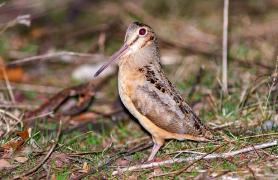When you’re walking in the woods this fall, you’re likely to kick up some acorns. These capped containers of energy are the seeds of oak trees. In fact, one oak can drop 10,000 acorns in a growing year. Some take root and grow into mighty trees, but others become groceries — or homes — for wildlife. Let’s look at six Missouri oaks and acorns and the critters that go nuts for them.
Bur Oak
Also known as mossycup, the bur oak bears the only native Missouri acorn with a characteristic fringe. It’s also the state’s largest acorn, measuring ¾–2 inches long. Many kinds of animals (including humans!) eat the mossycup, but the little acorn weevil grub lives in it. Once the grub exits the acorn, it burrows into the ground to become a skinny-nosed brown beetle.
Chinkapin
This acorn has a bowlshaped cap that is thin and hairy, and the scales are small and flattened. Sweet chinkapin acorns serve as crucial winter food for wildlife, especially the whitetailed deer. One deer can eat as many as 300 acorns a day!
Acorn ID
Size, color, shape, and texture are some of the things to note about the acorns you find. The cap, including the stem, is the part that covers the nutshell, and it’s usually easy to snap off. The cap has its own features to study, especially the scales. In the bur oak’s case, the scales along the edge of the cap produce a mossy fringe. If you can ID the acorn, you can ID the kind of oak it fell from.
Swamp White Oak
You might find these acorns in clusters of one to three. The cap covers about half the nut. It has flattened scales, and sometimes a short fringe on the border. Blue jays gather and bury only the best, weevil-free acorns they can find. Scientists give the birds credit for helping spread oak forests after the last ice age, about 11,000 years ago.
Did you know?
Blue jays have expandable throat pouches that can hold up to five acorns at a time!
Pin Oak
The acorns of this member of the red oak family are small, striped, and round. The shallow cap covers about one-quarter of the nut. Although they’re bitter, they last longer than white oak acorns. This may explain why squirrels will eat white oak acorns but store pin oak acorns. Gray squirrel
Did you know?
Squirrels may store and fail to dig up nearly 75 percent of the acorns they bury. Why? Lots of predators eat squirrels, so they may not live long enough to clean out their pantries.
Northern Red Oak
These acorns are barrel-shaped and hairy at the cap end. Many kinds of wildlife, including blue jays, woodpeckers, mice, squirrels, raccoons, deer, and especially turkeys depend on these long lasting nuts for winter food. If you find a patch of bare ground with V-shaped marks, you know turkeys have been scratching for acorns.
Southern Red Oak
This small, round, faintly striped acorn looks a little like a pin oak acorn, but the capcovers more of the nut. Raccoons are among the many kinds of wildlife that snarf down this bitter but nutritious acorn in the fall and winter.
White Oaks and Red Oaks
Missouri’s 19 kinds of oaks fall into two groups — white and red. White oaks include post, bur, swamp white, chinkapin, overcup, dwarf chestnut, and swamp chestnut oaks. Their leaves are rounded and lack bristles. Their acorns mature in one year, and they are sweeter than red oak acorns. Red oaks, also called black oaks, include the true black oak, the northern red, southern red, pin, shingle, willow, water, blackjack, cherrybark, Shumard, Nuttall’s, and scarlet oaks. Red oak leaves have little bristles or spinelike tips at the ends. Red oak acorns take two years to mature and they are very bitter.






































Also In This Issue

This Issue's Staff
Les Fortenberry
Karen Hudson
Angie Daly Morfeld
Noppadol Paothong
Marci Porter
Mark Raithel
Laura Scheuler
Matt Seek
David Stonner
Nichole LeClair Terrill
Stephanie Thurber
Cliff White






















